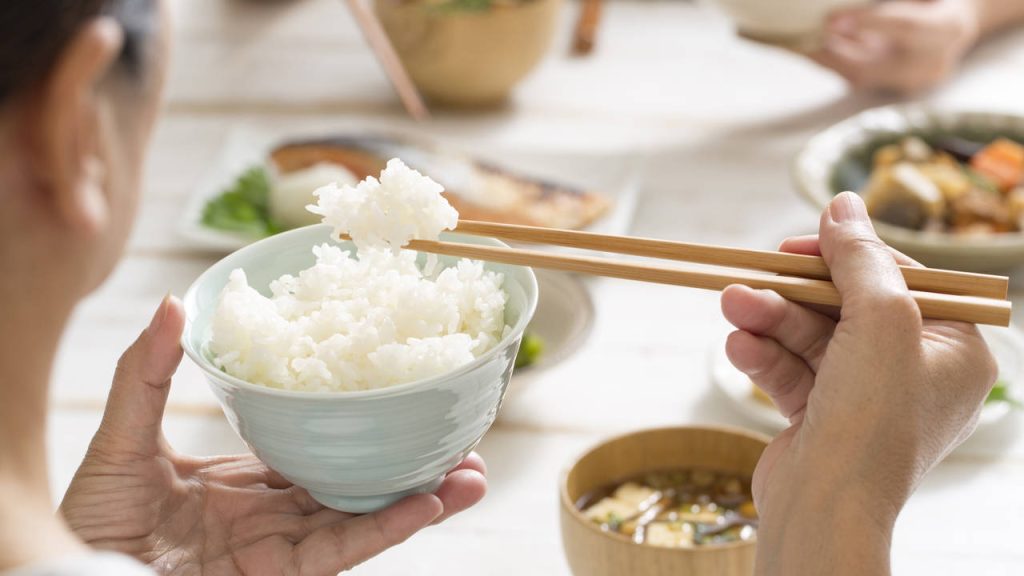Find out how many calories rice has, why it is more suitable for diabetics and celiacs than other energy foods and other cereals and all its advantages.

All foods are necessary and have their specific qualities. But if we had to choose the most beneficial for the body and mind, rice would be one of the main candidates.
He is generous, humble and abundant. It calms the hunger of the most disadvantaged and lends itself, in turn, to dishes of elaborate realization. However, many people wonder: is rice fattening?
IS RICE FATTENING? ENERGY AND NUTRITIONAL VALUE
Rice contains very little fat, about 0.2%, but provides enough calories (347 per 100 raw gene and 118 calories cooked) and a high percentage of carbohydrates (78%)). However, keep in mind that its glycemic index is lower than that of other foods of the same style, such as bread or potatoes.
The result of such a characteristic is that it does not produce a rapid rise in blood sugar, but is metabolized more slowly. This happens especially in brown rice, which is important for the diabetic diet, which tolerates this food well, and to a lesser extent with basmati.
In addition, rice starch is digested better than that of other foods and celiac patients can consume it safely, as it lacks the gluten present in other cereals.
The richness in fiber is 1.4 g / 100 g, in the case of cooked brown rice, and 0.5 g / 100 g in the white.
It has less protein (7%) than wheat (11%), but of higher quality. The amino acid tryptophan stands out, with relaxing properties of the nervous system.
It emphasizes the richness in vitamins of group B (B1, B3, B6 and folic acid), especially in brown rice, important for energy metabolism and the proper functioning of the nervous system (memory, learning, etc.).
Rice contains various minerals, especially magnesium (muscle and nerve activity), iron (antianemic), phosphorus (bones, muscles, brain), manganese (energy production) and selenium (antioxidant).
WHITE OR BROWN RICE?
Unlike white rice, brown rice preserves the germ, vitamins, and minerals intact.
The rice grain is wrapped in a husk that contains the germ, rich in proteins, vitamins and minerals. If only the most superficial husk is removed, then we speak of brown rice, the healthiest.
Brown rice provides six times more magnesium than white, four times more vitamin E, triple fiber and phosphorus, half more potassium and about three or four times more B vitamins.
That last point, together with its richness in tryptophan and slow-absorbing carbohydrates, makes it a food that favors peace of mind, counteracting the ups and downs of mood and energy.
WHY SHOULD WE EAT RICE EVEN IF IT IS CALORIC?
Rice is grown and consumed all over the world. Literally half of humanity has in the versatile and economical rice the fundamental food of its diet. And this is possible because its nutritional qualities make it a food with multiple healthy properties:
RICE IMPROVES THE DIGESTIVE SYSTEM
Rice is not counted among the allergenic foods. It also does not contain “goitrogenic substances” (which alter the thyroid gland), oxalates or purines.
The goodness of rice is verified in relation to the fact that it both helps fight constipation (although its fiber content is discreet, especially if it is polished), as well as diarrhea.
Also, the mucilages it contains soften the intestinal mucosal in the event that it is inflamed.
The famous rice water that is obtained by boiling it has a remarkable astringent effect, very convenient in the typical diarrhea of gastroenteritis. It’s also a great way to rehydrate.
Some studies indicate that dietary fiber may be beneficial for people with irritable bowel syndrome. Although other studies seem to suggest, equally, that adding wheat bran to the diet of these people is not always beneficial.
So, it has been thought that perhaps the problem in such cases is an intolerance to wheat, frequent in these patients. A good solution would be, therefore, that the contribution of fiber was through the intake of brown rice.
RICE IMPROVES CARDIOVASCULAR HEALTH
In cases of high blood pressure, rice consumption can contribute to its normalization, thanks to its low sodium content and the presence of potassium, which increases diuresis or urine formation.
Also, people with edema (accumulation of fluids in certain parts of the body) can take advantage of the properties of rice in this regard.
The presence of magnesium, especially in brown rice, helps fight possible spasms of the heart muscle or coronary arteries.
Another way that rice contributes to the good condition of the cardiovascular system is by helping to reduce excessive cholesterol levels.
It is explained by its remarkable fiber content, if it is integral, and by the presence of a component (gamma-oryzanol).
Rice bran has apparently been shown in some studies (in the United States and Australia) to lower cholesterol levels due to a decrease in LDL (“bad”) cholesterol levels and an increase in HDL (“good”) cholesterol levels. In these studies, rice bran is shown to be more effective than wheat or oat bran.
Also, the vitamins of group B (especially B6), present in brown rice, protect against cardiovascular risk due to a decrease in blood homocysteine levels, a molecule harmful to the walls of blood vessels.








